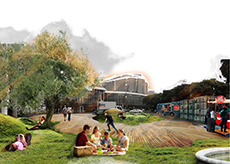Landscape architecture students win Australasian competition

Three landscape architecture students from Victoria University of Wellington have won the Australasian student design competition at This Public Life, a landscape architecture festival held in Melbourne.
The competition required participants to design more inclusive public spaces in cities.
Alex Prujean, Kathryn Nguyen and Michael Cook impressed the judges with their collaborative entry Aftershock, which proposes a web of disaster-resilient inner-city parks to function as safe havens where people can meet, play, and interact with nature in Wellington’s Te Aro suburb.
Competition judge Ricky Ricardo says he and the other judges were “overwhelmed by the high number and standard of entries, but the finalists we chose stood out as thoughtful and innovative concepts that cut across social boundaries.”
In the event of a natural disaster, Aftershock’s web of parks would function as disaster relief zones.
“Aftershock proposes that the majority of Te Aro occupants would be within 200 metres of a park while at work or home. This means everyone would have access to a safe place if a natural disaster occurred, or could move to another park if the one closest to them became unsafe,” says Alex.
While planning their design, the students considered responses to recent natural disasters, including the Christchurch earthquakes, and the earthquake and tsunami in Japan.
“We found that once the basic psychological needs of Christchurch residents were met after the 2011 earthquakes, it was important to have somewhere where people could meet and socialise with each other. The parks proposed in Aftershock would provide spaces for this to happen in the wake of a disaster,” says Alex.
The runners-up were also landscape architecture students from Victoria University.
Tama Whiting, Sian Du and Christine Blunden’s entry, Urban Streaming, is an inner-city wetland design aimed at enhancing social interaction with water by exposing a historic stream in Wellington’s CBD.
“We think it’s important to create public spaces that encourage pastime interactions and sensorial engagement,” says Tama.
“Our design was influenced by the way Māori are connected to the landscape, and the respect they have for its natural form.”
For more information contact Ian Letham on 04-463-5105 or Ian.Letham@vuw.ac.nz
